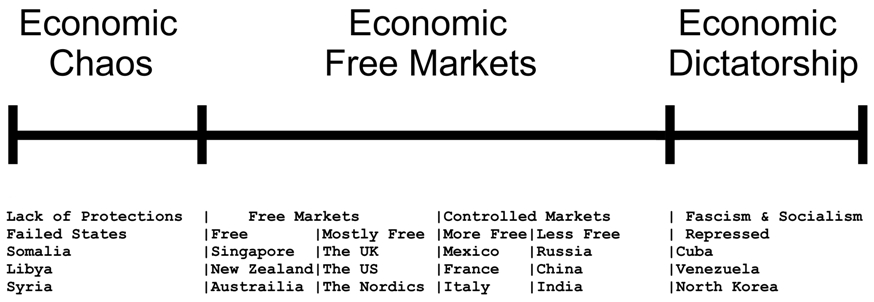


Economic systems differ widely in the choices the people in the economy are allowed to make. In the world today the economies of the various nations vary widely. At the extremes are chaotic failed states like Somalia, Libya and Syria where the government is unable to regulate choice at all and at the opposite extreme are the totalitarian states like North Korea, Cuba and Venezuela where choice is highly regulated. The former states are in economic chaos and the later economic dictatorships. All of the other countries in the world lie somewhere in between. You might be shocked that I said that failed states allow too much choice; you may wonder how can there be too much choice. Sadly, left to themselves some people choose to deprive others of life, freedom or property. In failed states these people run amok and destroy any hope of a functioning society. Allowing everyone to make any choice results in chaos where choice is limited by how hard you are able to fight for it. A livable country requires government to protect life, liberty and property. At the opposite end of the spectrum the government controls most aspects of your life, there is virtually no liberty, and the government owns or strictly controls all property. The United States was the first country to experiment with a limited government that did little more than protect life, liberty, and property. It took 75 years to include enslaved persons and even longer to protect the indigenous population. But it was a new idea, that had never been tried before and it takes time to reverse ten thousand years of human history. This experiment quickly led to the development of free-market capitalism which led to the industrial revolution and 200 years of unprecedented economic growth. Free-market capitalism has two parts: freedom in buying and selling and using capital investment to produce new and better products. Currently, several countries actually have more choices available than those allowed in the US. Most however allow far fewer. At the extreme the systems limiting choice most go by several names, fascism, socialism and communism. In fascism the government is totalitarian and strictly controls property and the means of production. The state tells producers what they can make and in what quantities. In socialism, the government nationalizes property and the means of production. In communism, the theory is that all the people together would own everything and government would be unnecessary but there has never been an example of a country where this was actually implemented. When a government takes over the running of one of the means of production or a property that is movement toward fascism. When a government nationalizes, that is takes ownership of, a means of production or a property that is a movement toward socialism. People often ask about the Nordic countries and democratic socialism. This myth came about from the term they use to describe themselves, social democracies, being misinterpreted. Most of the Nordic countries, while they have a more comprehensive welfare system than in the US, have less government restrictions on freedom than the US.
If you found this article stimulating, please share it with other folks who might enjoy it. And please share your thoughts below. Dr. Cardell would love to hear from you.

Responses